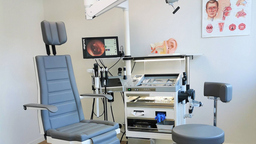Welcome to the ENT Practice Pfäffikon SZ
The practice is centrally located at Churerstrasse 47 in Pfäffikon SZ and is easily accessible by both public and private transport. Parking spaces are available nearby. The wheelchair-accessible practice on the first floor can be conveniently reached by elevator. The premises are bright and modern, equipped with the latest technology for comprehensive diagnostics. Thanks to modern examination methods, findings can be displayed on a screen and discussed with patients. Hearing assessments are conducted in an open hearing booth with natural light. Minor surgical procedures can be performed on-site under local anesthesia in the integrated practice operating room.
Services:
Snoring / Sleep Apnea
Snoring (rhonchopathy) results from vibrations in the throat’s mucosa. Narrowing of the upper airways can cause airflow turbulence, leading to these vibrations. Such constrictions are often due to anatomical obstacles, such as enlarged tonsils, a long uvula, or a large tongue. Muscle relaxation in the upper airways can also contribute to these restrictions.
Ears
The ear is a complex organ where direct assessment is only possible up to the eardrum. However, various tests can evaluate middle and inner ear functions. The most common examination is an audiometry test, performed on both adults and children. For younger children, hearing tests can be conducted using otoacoustic emissions. Tympanometry evaluates eardrum movement, providing insights into middle ear function. The ear also contains the vestibular system, which is crucial for balance (see "Dizziness" section). Ear surgeries, such as earlobe corrections, can often be performed under local anesthesia in the practice, while middle ear and eardrum surgeries are conducted in hospitals.
- Ear pain (e.g., infections of the ear canal or middle ear)
- Blocked ears
- Hearing impairments (hearing loss) including expertise in hearing aids (AHI / IV / SUVA)
- Tinnitus (ringing in the ears)
- Eardrum perforations and chronic middle ear infections
- Protruding ears
- Skin tumors on the auricle
- Ear fistulas
Dizziness
Dizziness can have various causes, but it often originates from the vestibular system in the inner ear. Clinical examinations and diagnostic tests (e.g., video head impulse test, caloric test) can assess vestibular function, distinguishing inner ear-related dizziness from other causes and enabling targeted treatment.
- Positional vertigo ("crystals shifting in the inner ear")
- Vestibular dysfunction ("failure" of the vestibular organ, inner ear disorders such as Meniere’s disease)
Facial Paralysis
Unilateral facial paralysis often involves the facial nerve (nervus facialis), which runs through the middle ear and parotid gland. Differentiating it from a stroke is crucial, and an ENT examination can usually clarify the cause.
Throat
In addition to clinical examination, ultrasound and fine-needle aspiration biopsies are available for further assessment. Treatments depend on the cause and can be either conservative (e.g., medication) or surgical.
- Swelling and lumps in the throat, including the thyroid gland (e.g., enlarged lymph nodes, cysts, thyroid tumors, goiter)
- Pain, swelling, or lumps in the salivary glands (e.g., due to salivary stones or salivary gland tumors)
Nose
Since only a small portion of the nose and sinuses is visible externally, endoscopy under local anesthesia is often used for evaluation. In addition to breathing, the nose plays a key role in the sense of smell, which can be tested. Allergies are also significant and can be assessed. If conservative treatments do not lead to improvement, surgical intervention may be considered.
- Nasal breathing obstruction (e.g., deviated septum, enlarged turbinates, polyps)
- Sinus infections
- Runny nose
- Nosebleeds
- Olfactory disorders
- Nasal fractures
- Skin tumors on the nose
Skin
The skin of the face, nose, and ears is frequently exposed to the sun, increasing the risk of skin cancer. Skin changes should be evaluated, and small tissue samples can be taken under local anesthesia. If skin cancer is confirmed, surgical removal can be performed in the practice’s operating room under local anesthesia.
Children
Children are always welcome! For young children, hearing assessments can be performed using otoacoustic emissions. The adenoids and tonsils can be examined directly or via endoscopy. Surgeries for children are usually performed in hospitals.
- Hearing loss
- Middle ear effusion
- Frequent middle ear infections
- Frequent tonsillitis
- Protruding ears
- Snoring with breathing pauses (sleep apnea)
- Nasal congestion
- Neck swelling (e.g., cysts)













